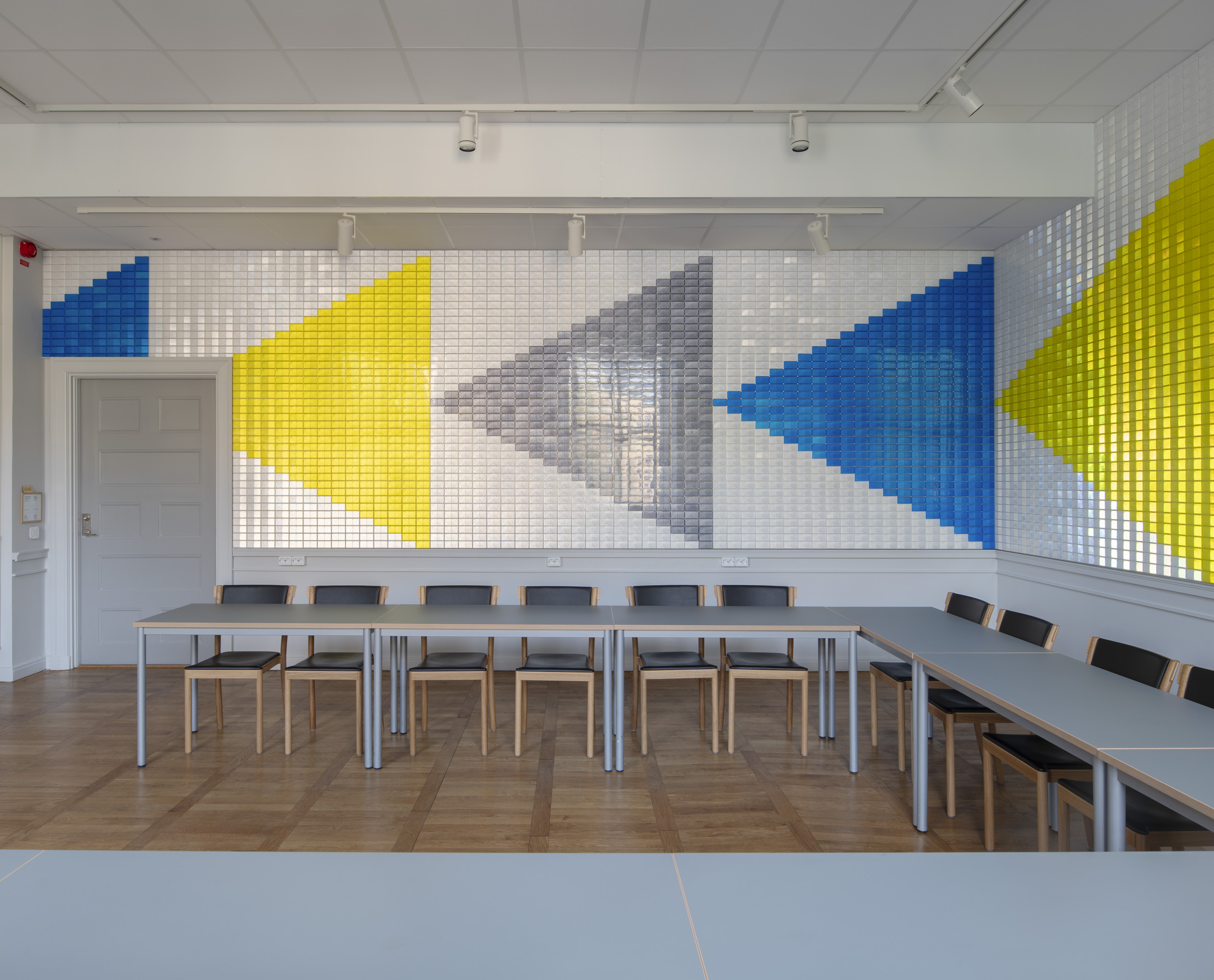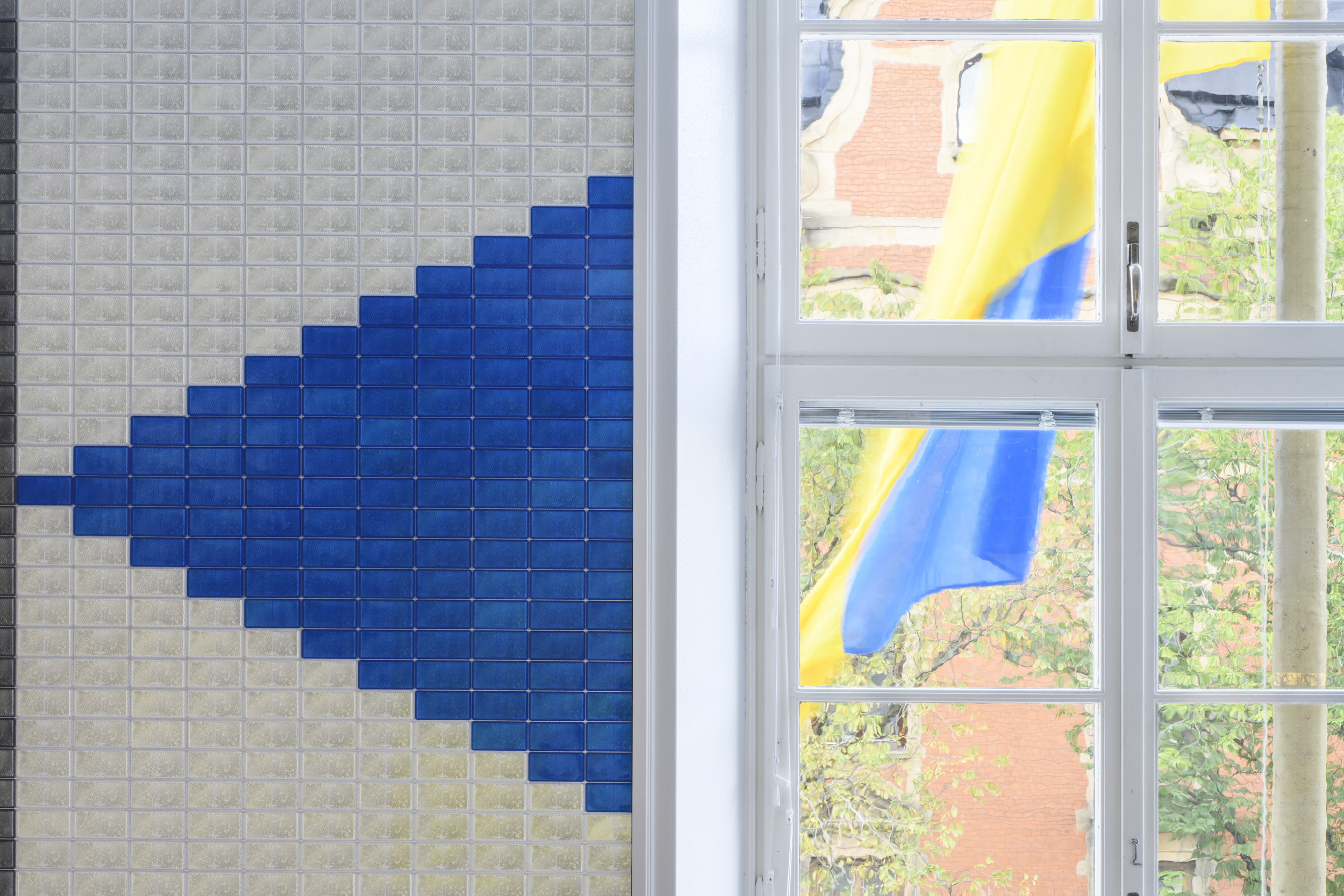The Rana Begum Room

Photo: Mikael Olsson
Light and order are fundamental to the process of the artist Rana Begum. In her minimalist and abstract art Begum blurs the boundaries between sculpture, painting and architecture. We can see traces of the urban landscape in her art - as well as geometric patterns from traditional Islamic art and architecture.
The Rana Begum room at SSE is an installation of reflectors, refracting the light in the room.
Rana Begum graduated with a BA in Fine Art from Chelsea College of Art and Design in 1999, and, in 2002, she gained an MFA in Painting from Slade School of Fine Art. She lives and works in London.
The room was made possible thanks to a generous donation by the SSE alum Doctor Anne Weidemanis Mägi, class of 1987.
No.1317 Reflector, 2023 by Rana Begum (Reflectors on aluminium 275 x 1686 x 2) was installed in the summer of 2023 by Rana Begum and her studio in cooperation with the installation team Kim Norström, Jenny Danielsson and Simone Schmid (Konstkompaniet)
 Detail of The Rana Begum Room and the Ukrainian flag ouside the school. Photo: Mikael Olsson
Detail of The Rana Begum Room and the Ukrainian flag ouside the school. Photo: Mikael Olsson
Reflection by SSE President Lars Strannegård - The Rana Begum Room
Rana Begum is a Bangladeshi-British artist who appears, at first sight, to work within a minimalist, modernist tradition. The genre is well-established in Europe and the United States with forerunners such as Piet Mondrian, Robert Ryman and Olle Baertling. Though Begum cannot be termed exclusively a sculptor, she is in all events an artist who works three-dimensionally. Her work reveals a finely tuned sensitivity to color and a frequent sense of playfulness in all her austere, stripped-down asceticism. This subtle sensitivity to color values is clear to see in much of her work, particularly in the translucent metal sculptures reminiscent of clouds. Begum creases colored sheet metal, paints roof tiles, and lays out paving bricks in unexpected tones and patterns. She is a color artist. Yet the more of Rana Begum’s art one sees, the more clearly another central tenet of her work becomes clear. Remarkably often, her work revolves around light and reflecting surfaces. Begum is thus not only a color artist, but an artist of reflection.
In preparing for the installation of her commissioned work for a classroom at the Stockholm School of Economics (SSE), Rana Begum requested that the movement of light in the room through an entire day and night be filmed. She wanted to study its slow movement across the walls, see where the sun fell at which times, as dawn would glide over into morning, move on toward noon and to dusk before finally darkening into night. The light in Sweden is very different from that in Great Britain, and from that in Bangladesh. The Stockholm light also differs from January to February, and from the third to the fourth floor of architect Ivar Tengbom’s building at Sveavägen 65. Light itself, its reflection and its redirection are not generic. Rana Begum is deeply aware of this, and the reason she was asked to create an installed artwork for one of the school’s classrooms was precisely because of her preoccupation with reflections.
SSE has a stated objective for its entire educational program, embodied in the acronym FREE: F for a fact- and science-based mindset, R for reflective and self-aware, E for empathetic and culturally literate, and E Entrepreneurial and responsible. At the core of SSE is hence a scientific and fact-based outlook, and the ability to reflect is a fundamental component of that position. Facts and information cannot become knowledge and science without the agency of a cognitive, human process – that of reflection. This is a process that machines and artificial intelligence cannot perform. The reason for this, at least so far, is that they lack what could be called a consciousness. The act of reflection is a human ability and action. A person is presented with data, information or assertions. In order to assess the veracity or the meaningfulness of what has been presented, the person must take a mental step back, process the information, and ask such questions as, is this right? Are these contentions, these claims, at all true? Is someone trying to exert influence on me? Impose power? Deceive me? Am I trapped in my own convictions? A qualified, well-substantiated understanding of any idea or statement can only be attained through reflection. There are no shortcuts.
A reflective approach means that the world, as it first presents itself, cannot be taken for granted. To engage in reflection means using oneself and others as a sounding board, as it were, to test the resonance of one’s thoughts. The aim of the academic seminar – generally regarded as one of the most important components of science and research – is indeed to induce reflection. It can be misleading to think that reflection and discussion can be equated. A discussion is the exchange of held notions, of arguments and of viewpoints, though not necessarily in a problem-solving or dynamic manner. Discussions often do not allow room for the conscious consideration and re-consideration of experiences and knowledge. High-quality scientific, academic contexts should not be the place for discussions, but rather for reflections. That is to say, for conscious, truth-seeking, open, probing and empathetic exchange of thoughts.
A good instructor will ask their undergraduate or doctoral student questions that call for reflection. “What question are you really trying to answer?” and “Now that you have presented your results, what do they mean?” Academic research is seldom about direct answers, and more often about identifying new questions. And these arise from reflection, from the perspective often gained by taking a step back. Engaging in reflection enables a new perspective and allows a view to the world from a slightly different angle. This is why consideration, mirroring and re-mirroring, is so central to a reflective approach.
Reflection can also be a process of its own. When reading a book for instance, and struck by a thought-provoking or powerful passage, you may lay the book aside and let your thoughts wander. Reflection also occurs in the formulation of a thought, in the articulation of an idea. As social psychologist Karl Wieck once expressed in his dictum about the reflective potential in writing, “How can I know what I think, until I see what I say?”, or re-cast in a parallel for speech, “How can I know what I think, until I hear what I say?” It is the articulation of an idea that that allows us to express, and thereby understand, our own ideas, feelings, attitudes and values. This what Rana Begum makes it possible for us to do. She allows us to see our surroundings, the world, from a different perspective.
The Rana Begum room at SSE is an installation of reflectors, refracting the light in the room. Standing in the space, just a step to a different position makes the walls suddenly look changed from a moment before. The light shifts. At first sight, the walls of the room are made up of reflectors in four colors – white, gray, blue and yellow. But it soon becomes apparent that the nuances are endless; the fluctuations and the refractions create either a silvery luster or a gold-colored gleam, depending on the weather or the time of day. The colors evoke the luminescence and playing shadows of the sky: Blue and gray, the yellow glow of the sun, and the splendor of white clouds. Only three of the four walls are overlayed with reflectors, the fourth remains bare in respect for lectures and teaching. The student is virtually surrounded by all the possibilities of reflection and light, which invite thought and afterthought, while not forcing attention away from the lecturer. The reflectors are not meant to compete for attention, but inspire the students to draw slightly back, to contemplate the substance of what is being presented from the lectern.
Certainly, Rana Begum’s work is both Minimalist and Modernist. Yet the reflection that the room brings to mind is of the hundreds, maybe thousands of reflectors covering the walls. Surely, we can see the walls as a mosaic, though as an ancient technique and aesthetic far from what we usually associate with stark Modernism. Associations to Asian traditions, to stone paving, tile-clad walls, Oriental carpets and textiles, are close at hand. Or are we looking at pixelated images? A Modernist language in form and color, but formulated in a digital-era dialect? Maybe all of these at once? Perhaps the reason for Begum’s international renown is her ability to present as minimalistic and austere, while her work is teeming with varied interpretations and associations. Her worldwide acclaim may well lie in this very ability to stir reflection in a world that allows ever less space for afterthought.
Lars Strannegård, President and SSE Professor